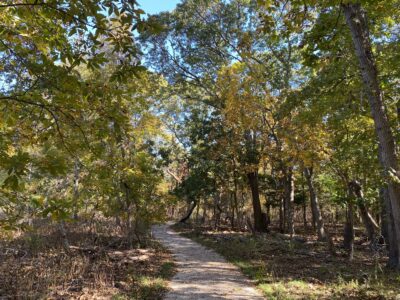Blog
Exploring Wolf and Reese Preserves
By Yvette DeBow-Salsedo
A more beautiful day could not have been planned for this past weekend’s walk at the Wolf and Reese Preserves in Southold. Under the expert guidance of naturalist John Turner, we saw and heard a wide variety of wildlife and plants, learned about the ongoing impacts affecting birds, plants, animals, reptiles, and amphibians that call the preserve home and the ways that we all can do our part to promote and support healthy habitats for everyone.
We were guided by John along the newly blazed trails – made of permeable materials, with gentle slopes and wide paths to allow for wheelchair and stroller access across 50 acres of protected land that runs from Main to North Bayview just to the north of Peconic Bay.
During this amazing springtime stroll, we stopped to see and listen for a wide range of migrating songbirds, raptors, and water birds that floated above, and flitted between, the beautiful canopy of red oak, red cedars, sassafras and many others.
Among the birds we saw (or heard) were Tufted Titmice, House Wrens, Chickadees, Hairy Woodpeckers, Red-bellied Woodpeckers, Orioles, Eastern Robins, Cardinals, Red-winged Blackbirds, Pine Warblers, Mourning Doves, White-breasted Nuthatches, and Carolina Wrens; and birds of prey Osprey and Red-tailed Hawks.
While this may seem like a lot, John expected to hear (or see) more songbirds as this is the prime time for their arrival and settling back in the area. We are seeing healthy returns of birds including bald eagles and osprey, but birds continue to be under stress particularly along migration paths. Conservation of land and protection of water help provide these beautiful and beneficial creatures with the resources they need to make these journeys, and underscores why ongoing protection efforts continue to be important.
![block.image[0].title](/assets/images/John-Turner-speaking.JPEG)
A special surprise along the way, we viewed (and were curiously watched by) two young red fox (with their distinctive white tipped tails) who played just outside their den while their parents were off hunting for “lunch.” The two siblings looked healthy and happy, a positive ray of light!
Another stop along the way, and John pointed out the habitat for the lead-back morph of the red-backed salamanders. These salamanders don’t require a water source, but rather their habitat is on the underside of fallen trees that maintain a moist environment.
The woods of Wolf and Reese provide a wide array of habitats for birds, fox, and many other animals. The cavities of trees (dead, dying or still alive) are important nesting areas for birds and bats. The bark, leaves, and understory offer food resources. We learned about “partition feeding” – where some birds prefer the nutrients from the leaves and others from the bark. Additional partitioning by birds for deciduous vs. coniferous trees enables the forest to provide food sources to a wider variety of birds.
Our thanks go to John, who brings nature alive and helps us connect in ways we couldn’t imagine. We can’t wait to explore again!
Interested in checking out these preserves? There are now four trails that meander through the preserves. Along the way, look for signs that talk about the plant and animal species that call the area home. You’ll also learn about new native plantings that have been installed by the Trust’s stewardship team. Signs and protective screening can be found throughout the preserve giving you a sense of the plants that we are hoping will re-populate to improve the health of this important ecosystem and habitat.
To learn more visit us at www.peconiclandtrust.org/explore.


